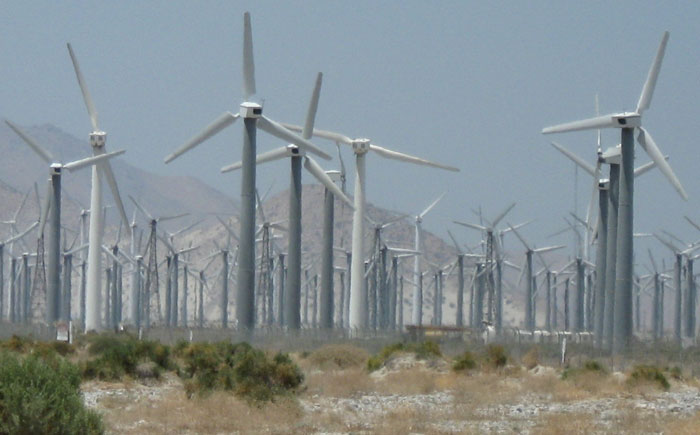Whatever Happened to 'Think Globally, Act Locally'?
^Palm Springs, California.
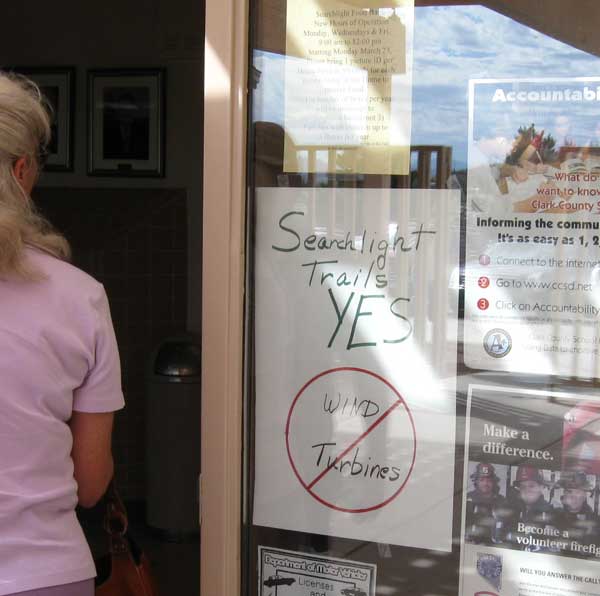
June 28, 2009, By LMC -
That was the mantra back when I attended the University of California at Berkeley in the 80's. Doing things locally, like growing your own vegetable garden, supporting local businesses, or producing and using your own electricity, was a serious topic discussed by everybody, while keeping an eye on the larger geopolitical scene. Sure Berkeley had a lot of crazy ideas too, but there was, and still is, a willingness to take personal responsibility for changing the world.
After I graduated and took a job with the California Department of Fish and Game in the Owens Valley, California, I saw how fiercely rural people would defend their place, their special landscape. I made friends with many local trout fishermen and elk hunters, as well as visiting hikers and vacationers -- tourists were always welcome here, but another side entirely was revealed to those from the city with grand plans, seeking resources to take (in this case water for Los Angeles).
Now that I have lived on a rural Nevada ranch for the last 8 years, I understand even better the close and detailed connection that local people can grow with the land. You learn exactly what landfill your garbage goes to because you have to take it there yourself (makes recycling seem a much better option), where the water from the kitchen sink drains to (the marsh nearby I found out), and when your well pump breaks down you learn quickly how to get down in the mud and fix it. Surrounded by bighorn sheep mountains on public land and neighbors raising horses and longhorn cattle, the view and lifestyle were the reasons I moved here.

^Turkey vulture.

^Searchlight hills.
Scoping Meeting
So when I attended the meeting for Duke Energy's proposed wind energy project by the rural town of Searchlight in southern Nevada, my mouth kept dropping open about how the mantra now seems to be "Think Globally, Act Globally."
The town had not let up on its concerns and disdain for the wind farm in five public meetings here at the community center (see our report on the January 2009 scoping meeting). About 100 people showed up, some new according to our local friends, to hear Bob Charlebois of Duke Energy explain how, yes, the original proposal for 160 wind turbines surrounding neighborhoods was "completely unacceptable to the town." Duke lowered the number of turbines to 140, and moved many of them away from town and south onto a gradual sloping basin side (see map). He admitted the plan will probably get even smaller as the concerns with placement of individual turbines is dealt with.
The meeting took place to continue to address the resident's questions: for three hours people stood up and told how they did not want wind turbines around their houses. Only one person said he thought the project was a good idea.
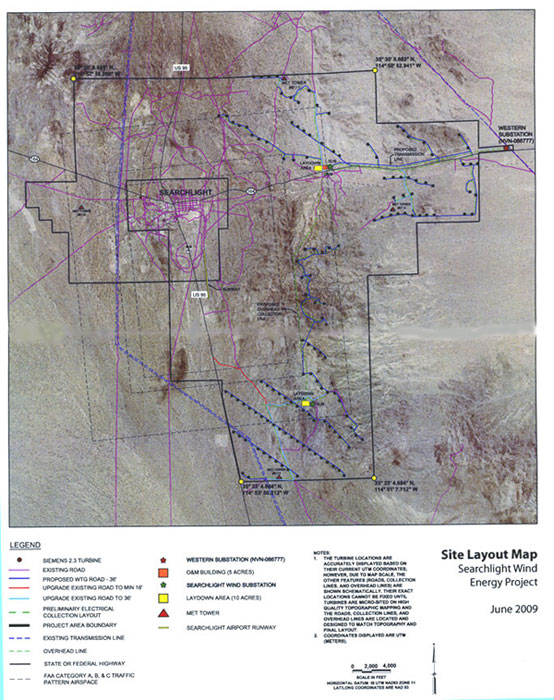
^Source: http://www.blm.gov/pgdata/etc/medialib/blm/nv/field_offices/las_vegas_field_office/ energy.Par.0221.File.dat/Searchlight%20Wind%20Energy%20Newsletter.pdf
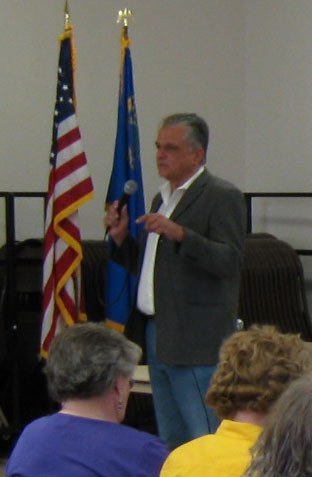
The panel also included two Bureau of Land Management (BLM) employees and Aaron English for URS Corporation, a San Diego-based environmental consulting company hired by Duke to work on studies (we note they have been hired by other renewable energy companies to prepare environmental studies on other renewable projects on public lands).
Clark County Commissioner Steve Sisolak chaired the meeting (<photo), but mostly told the audience how he was pushing for labor-friendly jobs for southern Nevada. He told us how Duke was negotiating with the county for money for county improvements, and that some would go to Searchlight.
To that, a 47-year resident of southern Nevada who had a house in Searchlight, told the panel, "Good old Searchlight is being thrown under the bus for carbon credits!"
A teacher from the College of Southern Nevada questioned why critical habitat need to be ripped up and vegetation removed. He wanted to know how much stored carbon in the landscape would be released into the atmosphere from the construction of these roads and turbine bases?
Charlebois told him, "Our biologists and scientists are studying all aspects of the environment." He said that there are no trees here like back East, and that this wind farm would be the equivalent of taking 30,000 cars off the roads. His wind farm would, he claimed, displace carbon-burning plants -- so it would be a "significant negative carbon" project.
All of these claims can be disputed: desert vegetation, soils, and microbiota store significant mounts of carbon (see our story 'Last Spring in Ivanpah?'); as for taking cars off the road, we do not understand how this could happen unless the cars are all electric; and again, due to the intermittent nature of wind power, it can be argued that more coal-burning and natural gas-burning power plants will have to be built as baseload to handle the influx of renewables into the grid.

^Joshua tree by the Searchlight Hills. Apparently Duke Energy does not consider this woody twenty-foot-tall plant a "tree."
Charlebois said if they find any rare plants , they will "sequester them."
"I am totally against this," exclaimed a local woman, asking why Searchlight had to be the choice for this wind farm. "Why not put them where no one lives?"
A man on the Searchlight town advisory board, resident for 18 years, was also "totally against" the wind project. It will ruin the view of Spirit Mountain to the south. "I moved to Searchlight because I'm a bird-lover," he went on, describing how hawks and eagles fly along the ridges here, and a wind farm would not be feasible. The Desert tortoise was also a concern to him, as well as the current placement of proposed wind turbines a mere 1.5 miles from the airstrip. "How long is the avian study going to be?" he asked. Bald eagles winter in adjacent Lake Mojave along the Colorado River. "I love the eagle," he ended.
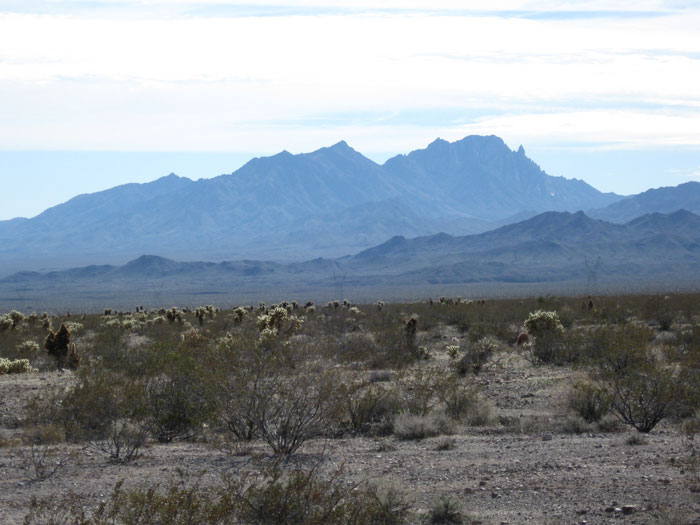
^Spirit Mountain south of Searchlight, near the proposed wind energy project. As well as being a local landmark to the town, this mountain is a very sacred site to many Native American tribes in California and Arizona.
Another local man asked why this project was so valuable, as wind was not the most efficient form of energy. "Is it to use up stimulus money?" he wondered. He commented that it would destroy the land here.
Charlebois countered that wind is efficient, and will be delivering electricity 90% of the time (he neglected to say often at only a trickle), and that the wind industry is pursuing the "holy grail" of storage of this energy generated by wind.
The commissioner read a written statement signed by 30 people, to "please keep the wind turbines two miles from houses and mines," or they would "sue for health reasons." They wrote how many people moved here for health reasons, so do not need more problems. Many people wanted to know exactly how close the turbines would be to houses. Charlebois admitted he could not tell them -- perhaps a few thousand feet. Someone in the audience yelled: "Try 500 feet!"
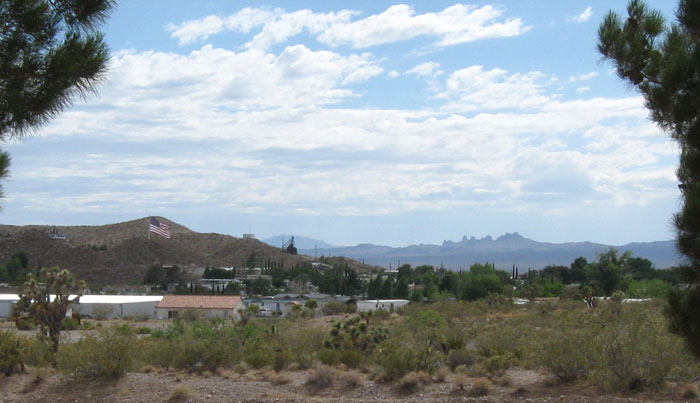
^Town of Searchlight.
A 50-year resident of Nevada with a house in Searchlight explained how he had an 800-watt wind generator at his place and "it won't blow for days during high pressure." It also killed a lot of birds, like Mourning doves, despite its small size. He was a hunter and wildlife enthusiast, and was quite concerned about the impacts of ten 400-foot tall monster turbines so close to his house. "This desert comes alive with animals," he explained, especially at night -- coyotes, bobcats, and two bighorn sheep herds passing through the mountain. "If you go hunting and get within a half mile, they go. So they won't tolerate turbines," he said. He also liked the Turkey vultures that frequent the area, and was worried they would be killed. "A lot of retired people here like animals. Go out at night, you can see them," he suggested to the panel.
Charlebois only responded by saying this will be studied by "qualified biologists." Mark Chandler of the BLM assured the audience that Duke has been very proactive with turbine placement, and that BLM had told Duke to move turbines from the northeast section of their proposed area, out of a bighorn sheep area within an Area of Critical Environmental Concern (ACEC). BLM is aware of the sheep, he reminded everyone -- "they are an adaptable species."
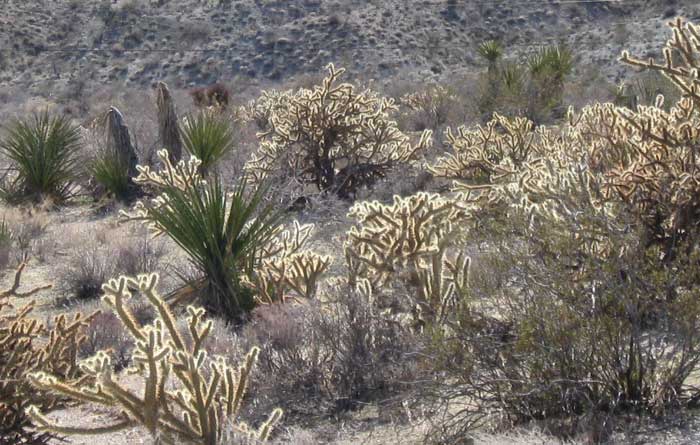
^Forest of Buckhorn chollas and Mojave yuccas on the site of proposed wind turbines and roads to access them.
We asked about views in public lands affected by the giant wind turbines, and night lights. Charlebois responded that this was "the toughest question." He joked about how you cannot really mitigate this, unless you can get invisible paint. (The audience did not laugh.) "It is inarguable that this project will have a big impact on the landscape." But some people may find them "aesthetically OK," -- "it is hard to quantify." He went on to say how special 3-D computer animation technology that will picture how the wind turbines will appear, made available by a team from New Zealand (why is an American company not hired to do this? This project is supposed to create local jobs...). "It's difficult to hide a 400-foot turbine."
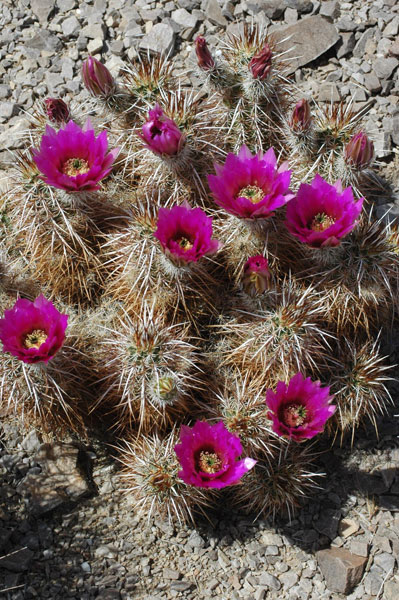
^Calico cactus in bloom.
Critical Wildlife Habitats Opened Up to Renewable Development?
Asked again and again why the turbines were so close to town, BLM's Mark Chandler reminded the people that Puite-Eldorado ACEC surrounded the town, and "back when we made the ACEC's, we did not consider wind and solar, so they are exclusive." But he said after 2009 BLM will look at opening up ACECs for wind and solar energy development. (This should be very troubling to anyone concerned with tortoises, rare plants, and other wildlife that are currently protected by these public land designations.)

^The ridge in the distance will have a row of 400-foot tall wind turbines along it if Duke's application is accepted. Searchlight Hills.
A Cup of Coffee
A local man who was a practicing engineer barraged the panel with a series of questions about the economics of the project. Wind does not work without considerable subsidies. What will the power cost at the end of the day? Venture capital cannot afford any more boondoggles. He wanted to see a cost analysis of what taxpayers would make up in the cost. Charlebois said federal and state governments have deemed that subsidies are needed. Tax credits will "certainly enhance this wind project." He claimed wind is the cheapest form of renewable energy, but that "we're competing against all other wind companies -- if Duke did not take advantage of the government's production tax credit as an incentive to build, "the next company will." The oil and gas industries are heavily subsidized -- "It's not a level playing field." He went on to say that the actual cost to the individual taxpayer would be something like a cup of Starbuck's coffee per year.
The engineer in the audience laughed and said all government agencies are adding this type of cost hundreds of times to the taxpayer-- that adds up. He said he had more questions, but he'd hold off.
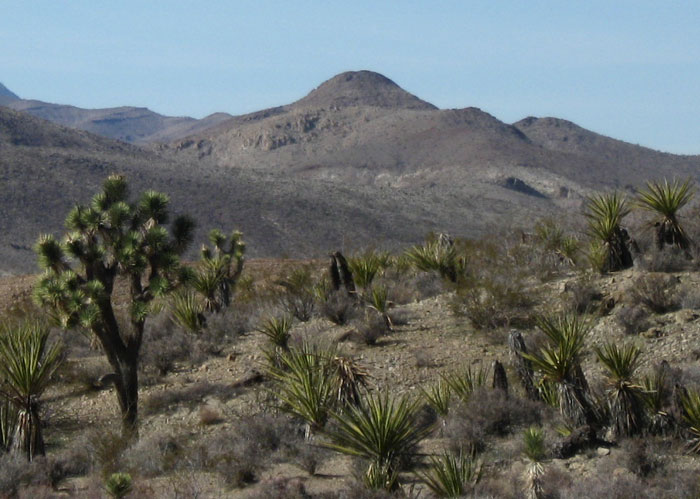
^Joshua trees and Mojave yuccas in Searchlight Hills.
A woman on the town board stood up next and said she moved away from Palm Springs, California 13 years ago get away from wind farms. "Go look -- you will see what they want to do here," she warned the audience. We came here to sit on the porch, look at Spirit Mountain, enjoy the quiet, get away from the noise..." She said to the audience that they needed to get a petition together against the wind farm. But then she asked rhetorically, "if we all said no, would it do any good?"
The county commissioner tried to reassure her, commending Duke and BLM for their work at this "delicate balancing act": looking at the "overall grid" he told the town, "this time it's falling in your backyard." He said if Duke doesn't think they can make money, they won't build it.He said the townspeople would have more opportunities for input in the draft environmental impact statement.
Bob Ross, field manager of the Las Vegas BLM office, stood up and told the audience, "I'm the decision maker." He reassured everyone that BLM is listening to the "input, emotion, and substance."
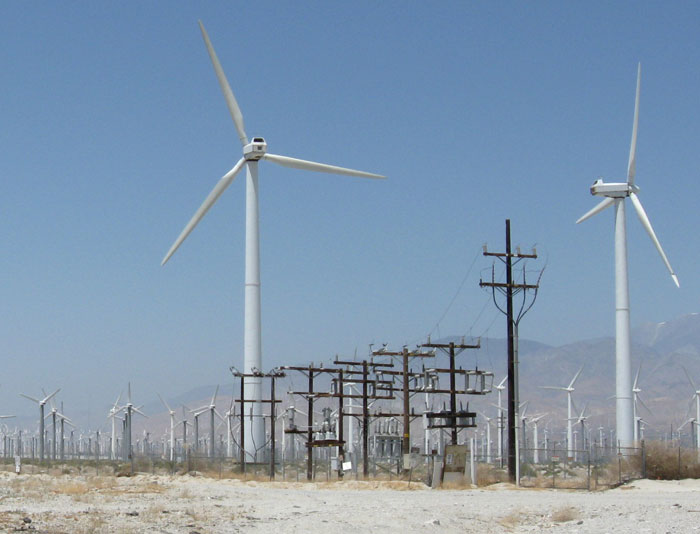
^Small and medium-sized wind turbines by Palm Springs. The huge turbines proposed for Searchlight would be twice as tall as these 200-foot turbines, at almost 400 feet in height.
A local woman gave an impassioned plea for the native vegetation and scenery. She was concerned about the environmental issues. She spoke of the Creosote -- "most people think of then as weeds, but they live to 11,700 years -- once you uproot them it takes a long time for them to regorw." She went on: "When we lose a joshua tree we lose a part of our cultural and natural heritage. How long will it take us to replace these things we casually dig up and throw away?... Are we going to give up the historical Southwest for these projects? These plants have been here for thousands of years."
Mark Chandler told her the BLM would be doing a habitat inventory and habitat restoration plan, placing plants in a nursery to save for replanting. (While BLM will require the movement and replanting of Joshua trees, they do not customarily do this for creosote and most other desert shrubs and cacti.)

^Flowering shrub buckwheat (Eriogonum fasciculatum) and Bursage (Ambrosia dumosa).

^Beavertail cactus (Opuntia basilaris).
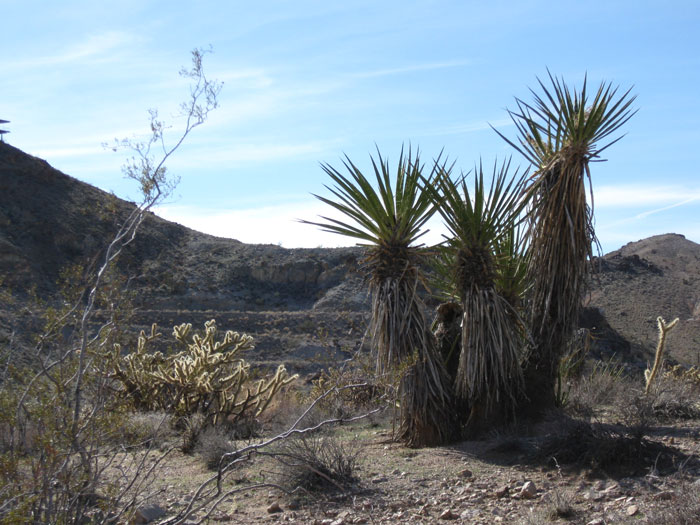
^A Creosote (Larrea tridentata), locally known as 'greasewood,' with Buckhorn chollas and yuccas. Searchlight Hills.
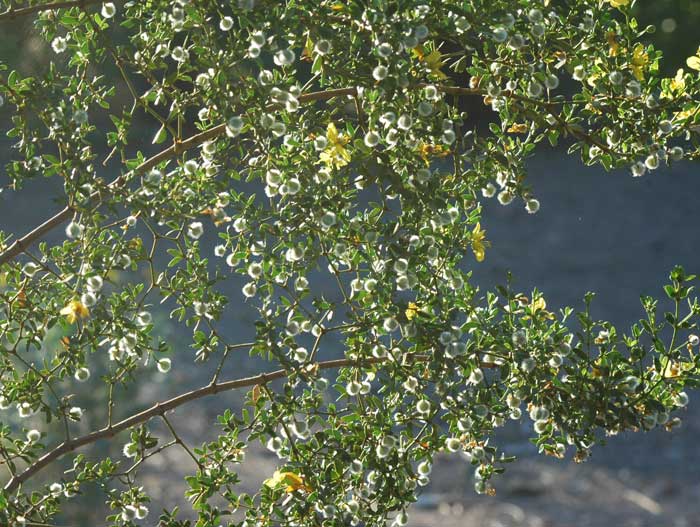
^Creosote with flowers and seeds.
A veteran and resident of nearby Cottonwood Cove by Lake Mojave, at the end of the road that would be lined with dozens of turbines, told the panel that the project would "ruin this prime view," the beautiful view going to Lake Mojave, a popular tourist destination for recreational boating and fishing. "I am a cynical man now about our government giving things away."
Chandler said "higher powers" made BLM follow this process. "We get a lot of pressure from Washington on renewable energy."
^Skeptical audience of Searchlight residents.
The Big Picture?
Las Vegas resident Scott Rutledge of the Nevada Conservation League explained to the locals that many of his supporters are "kinda twisted" on this issue of renewable energy. He said they want clean energy, clean jobs, to fight global warming. "I guess the first question is," he stated looking around at the people, "who all in this room believes the science that says climate change is one of the biggest issues facing the planet today? Raise your hands -- be brave." He moved on, lecturing on how the government has subsidized the nuclear and coal industry far too long. Big oil and coal companies are lobbying to kill the American Clean Energy and Security bill in Congress now, he said. (Duke Energy is one of those powerful lobby groups >>here. They have a 'blueprint' for the climate bill on their member website, United States Climate Action Partnership.) But he said even this current climate bill does not go far enough, giving away too many carbon credits, and not containing enough incentives for renewables.
Rutledge continued, telling the crowd that where he was from hunters can hunt around wind turbines (the hunter next to me laughed), and "outdoor enthusiasts can enjoy a very vibrant lifestyle" among wind projects.
"We have to do something, and we have to do it now, to head off climate change," he demanded. "We have to lead by example as Americans," he said -- the town can be "part of the big picture."
But this apparently did not convince most citizens of Searchlight. The comments and questions pressed on against the project: "Bottom line is, they're ugly," said one person; "Why are we doing this?" asked another.
A 42-year-resident of Searchlight angrily told the panel to not pay attention to the nearby towns of Boulder City and Laughlin when asking about public opinion on the wind project She "really resented" that these distant towns seemed for the project when BLM held scoping meetings in the past at those locations.
The teacher spoke up again, saying people know the Earth is warming, but this does not justify tearing up the desert.
One man stood up and told the panel he was for the wind project, but, "You've never answered our question: are you planning on putting more turbines than you're telling us?" He said Duke had approached him and other land owners about placing turbines on their private properties. Charlebois told him, "No, we're trying to please the most people."
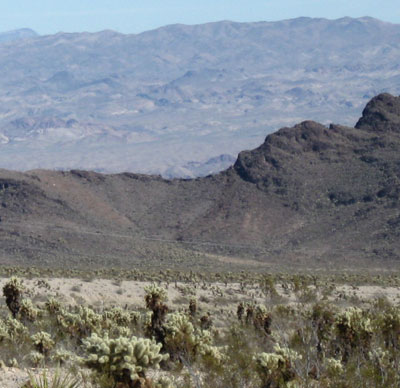
^Colorado River Valley in Lake Mead National Recreation Area a few miles to the east of the proposed Searchlight wind energy project.
No Resolution
The meeting ended without resolution for most people. Charlebois looked tired, and admitted that if the process had to restart, Duke would have to find someone else to be project manager.
I went up to the county commissioner and asked him if the county was planning on enacting legislation that would make feed-in-tariffs or loan programs for photovoltaic rooftops available, in case I built a house on the land I owned near Searchlight? "No," Sisolak told me bluntly. "How about tin the future," I pressed. "No, the state budget is broke, we can't afford that." He did not seem to have the time to discuss this further.
I later asked the experts about this, folks who are working tirelessly to push for distributed generation options over giant industrial projects and associated transmission lines. Here is the answer I got:
Feed-in-tariffs (FITs) are NOT PAID BY STATE BUDGETS, they are paid in the usual way that utility expenses are paid – by amortizing their cost across ratepayers. No tax dollars are used or allocated or budgeted or needed. If the program is designed as a “net meter then sell the excess,” there will be so little power purchased, and so little cost difference between the power bought at a premium (say, 50 cents/kWh) and the power sold (peaker power and top tier power in California can go for well over 40 cents/kWh), it will not even be noticeable, especially in comparison with the HUGE costs of Big Energy projects, including Big Transmission. The states are also getting lots of stimulus money that is perfectly suited for AB 811 – style loans (which may be used for efficiency upgrades and/or clean power production), so they should not waste that money on big Energy boondoggles, but rather flow it through to property owners (who will have to pay it back with interest, which will create a perpetual loan fund). This is all really simple, affordable, and possible – it just requires more grass roots pushback.
What is a FIT? >>click here.
The City of Berkeley pioneered AB 811 - style loans, called "FIRST" locally. It is a program designed to allow property owners (residential and commercial) to install electric and thermal solar systems and make energy efficiency improvements to their buildings and pay for the cost over 20 years through an annual special tax or assessment on their property tax bills. A number of other cities and counties followed. Individual property owners would contract directly with qualified private solar installers and contractors for energy efficiency and solar projects. The City would provide the up front funding for the project through proceeds derived from the creation of a bond, which is repaid from special taxes or assessment on participating property owners’ tax bills. See Berkeley Renewable Funding >>here.
If the cap-and-trade bill is going to add an extra "tax" to our electric bills, perhaps it would be better to go with this localized rooftop option via loans, and eliminate the utility altogether -- make all our own electricity. But most cities do not yet have this program, so we are at the mercy of large corporations like Duke.
We were invited to dinner by a group of local residents who were fighting the wind farm. The talk was how the outsiders did not understand what it was like to face a giant development project. We talked about fishing for "stripers" in the local reservoir, and bird-watching for hawks. They had seen rare Harris's hawks occasionally around town, a species I have only seen at Organ Pipe Cactus National Monument in southern Arizona. Residents here were concerned about how the bighorn sheep herds would react to the construction. One man said he calculated that something like 160 cement trucks would be driving on the old road into the mountain to make the bases for the turbines. They had all moved here decades ago for the views, the beautiful desert, the animals. People had bird feeders and quail blocks. The love of the land cut across Republican and Democrat boundaries, and the divide seemed to be more one of locals vs. outsiders from distant cities. They were patriotic about America, but were jaded with government intrusion. They were being asked to "act globally" by environmentalists more concerned with the Polar bear, but they all responded, what about the local animals? What about us?
I gained a lot of respect for the folks that deeply cared about their backyard, knew it intimately, wanted to preserve the local landscape. They had a deep sense of place that is becoming all to rare in today's world that pushes for global answers to global problems. These are important, but I couldn't help think that what we were fighting to preserve was about to be trampled under foot in the headlong rush to try to control the future. The Big Picture should, in fact, include preservation of our delicate local desert ecosystems.
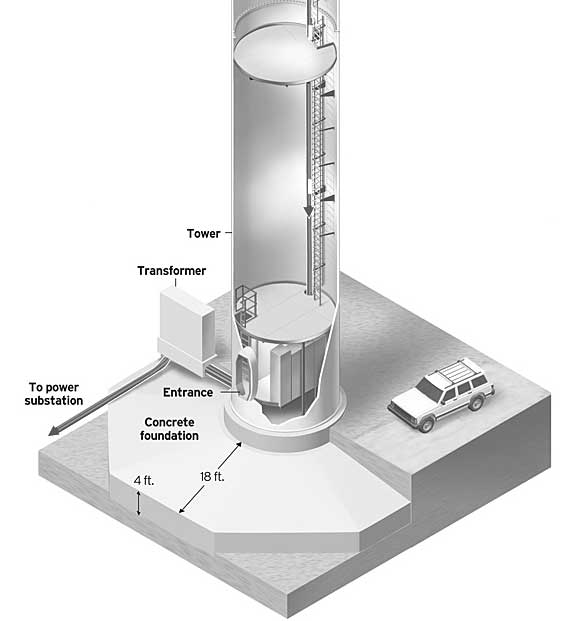
^Base of a 400-foot turbine tower, similar to that proposed for Searchlight.
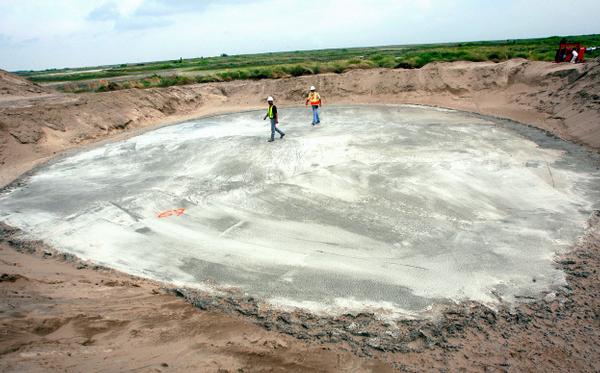
^Cement base foundation poured into excavated the ground, for a 400-foot tall wind turbine. Courtesy http://www.caller.com/photos/galleries/2008/apr/20/wind-farm-debate/5943/
Searchlight residents send in a bird and wildlife report >>here.
The scoping meeting covered by newspapers >>here and >>here.
Comments? Go to our Guestbook. 
HOME.....Searchlight Wind Project.....January 2009 Scoping Meeting
